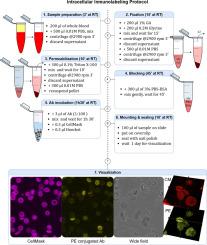共聚焦显微镜分析中红细胞抗血红蛋白F细胞内标记的优化方案
IF 2.2
3区 工程技术
Q1 MICROSCOPY
引用次数: 0
摘要
免疫标记和共聚焦显微镜的结合使用为红细胞的全面检查提供了一个强大的工具,可以清楚地看到特定蛋白质及其在细胞中的作用。虽然免疫标记是一种广泛使用的技术,但它在红细胞研究中提出了具体的挑战,包括膜渗透困难,背景荧光的出现,非常微弱的信号检测,其他血液成分的干扰,以及,值得注意的是,由于固定成分选择不正确而导致的保存不良。此外,新鲜血液样本非常不稳定,需要尽快保存,最好是在提取后立即保存。解决这些挑战需要仔细的实验设计,以确保测定的特异性和敏感性,往往是复杂的不完整或不明确的文献信息。在这项研究中,我们收集了关于红细胞免疫标记关键方面的可用文献数据,并设计了详细的免疫染色方案,以研究羟基脲治疗的镰状细胞性贫血患者中血红蛋白F的存在。该方案确保红细胞特征的适当保存,并可能在其他细胞内抗体的免疫标记中找到应用。本文章由计算机程序翻译,如有差异,请以英文原文为准。

Optimized protocol for intracellular labeling of red blood cells with anti-hemoglobin F for confocal microscopy analysis
The combined use of immunolabeling and confocal microscopy offers a robust tool for the comprehensive examination of red blood cells, allowing clear visualization of specific proteins and their roles in the cell. While immunolabeling is a widely employed technique, it presents specific challenges in the study of red blood cells, including difficulties with membrane permeabilization, the appearance of background fluorescence, detection of very faint signals, interference from other blood components, and, notably, poor preservation resulting from an incorrect choice of fixation components. Adding to this, fresh blood samples are very labile and need to be preserved as soon as possible, ideally immediately after extraction. Addressing these challenges requires careful experimental design to ensure assay specificity and sensitivity, often complicated by incomplete or unclear information in the literature. In this study, we have compiled available bibliographic data regarding key aspects of red blood cell immunolabeling and devised a detailed immunostaining protocol to investigate the presence of Hemoglobin F in patients with sickle cell anemia treated with hydroxyurea. This protocol ensures proper preservation of red blood cell characteristics and may find application in immunolabeling with other intracellular antibodies.
求助全文
通过发布文献求助,成功后即可免费获取论文全文。
去求助
来源期刊

Micron
工程技术-显微镜技术
CiteScore
4.30
自引率
4.20%
发文量
100
审稿时长
31 days
期刊介绍:
Micron is an interdisciplinary forum for all work that involves new applications of microscopy or where advanced microscopy plays a central role. The journal will publish on the design, methods, application, practice or theory of microscopy and microanalysis, including reports on optical, electron-beam, X-ray microtomography, and scanning-probe systems. It also aims at the regular publication of review papers, short communications, as well as thematic issues on contemporary developments in microscopy and microanalysis. The journal embraces original research in which microscopy has contributed significantly to knowledge in biology, life science, nanoscience and nanotechnology, materials science and engineering.
 求助内容:
求助内容: 应助结果提醒方式:
应助结果提醒方式:


